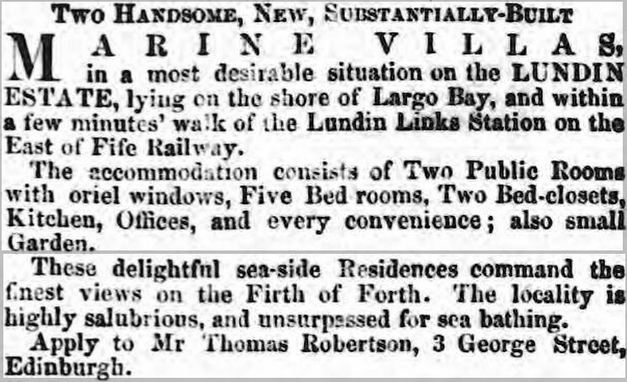The 1860 book "The Handy Book of the Fife Coast" by Henry Farnie had a full page advert for the development on its back cover (shown below) which used effusive language to sell the locality. In spite of all these efforts, by 1862 the lack of uptake saw building work cease and this phase of the growth of Lundin Links end. The reasons behind the failure of this particular venture most likely included a lack of attractions for tourist beyond the coastline itself (the golf club was not yet established and there were no other sporting facilities in the village), the basic nature of the local shops and inns, and poor provision of utilities such as water and gas supply and sewage disposal. Fundamentally, Standard Life's vision was premature - it would be another couple of decades before Lundin Links became fashionable!
|
Having purchased the Lundin and Aithernie Estates in 1852 (and the neighbouring Balcormo Estate in 1853), drawn up development plans, built Lundin Links station and a new village school, the Standard Life Assurance Company found that the feus which it was offering for sale in 1857, once the railway line had opened, were not being taken up. The anticipated rush of wealthy Edinburgh families commissioning holiday homes for sea-bathing and relaxation away from the city did not happen. So, in order to stimulate custom, the company built two villas on its own account in 1858 (source: 'Standard Life 1825-2000' by Michael Moss). The villas in question are now known as 'Old Calabar' (originally named Melville Cottage) and 'Oldfield' (originally named Bayview Cottage). This matching pair of villas (or 'cottages' as commonly referred to at the time) were designed by James Campbell Walker and sit either side of the old Lundin Mill School (now library) and its adjacent School Teacher's House. Below is an advert for the sale or let of these two villas dating from June 1859. Around 1860, Standard Life decided to build four more villas in an effort to attract holidaymakers (again using the architect James Campbell Walker). These are referred to in the 1861 census as "newly built" and unoccupied. These four dwellings must certainly be 'Haworth' and 'Homelands' on the Leven Road and two further "cottages" extending further along Crescent Road, namely 'Glenairlie' (once named Murree Lodge) and 'Bourtree Brae'. Around the same time, a big publicity push was on for the Standard Life vision of Lundin Links.
The 1860 book "The Handy Book of the Fife Coast" by Henry Farnie had a full page advert for the development on its back cover (shown below) which used effusive language to sell the locality. In spite of all these efforts, by 1862 the lack of uptake saw building work cease and this phase of the growth of Lundin Links end. The reasons behind the failure of this particular venture most likely included a lack of attractions for tourist beyond the coastline itself (the golf club was not yet established and there were no other sporting facilities in the village), the basic nature of the local shops and inns, and poor provision of utilities such as water and gas supply and sewage disposal. Fundamentally, Standard Life's vision was premature - it would be another couple of decades before Lundin Links became fashionable!
0 Comments
Your comment will be posted after it is approved.
Leave a Reply. |
AboutThis blog is about the history of the villages of Lundin Links, Lower Largo and Upper Largo in Fife, Scotland. Comments and contributions from readers are very welcome!
SearchThere is no in-built search facility on this site. To search for content, go to Google and type your search words followed by "lundin weebly". Categories
All
Archives
April 2024
|


 RSS Feed
RSS Feed
